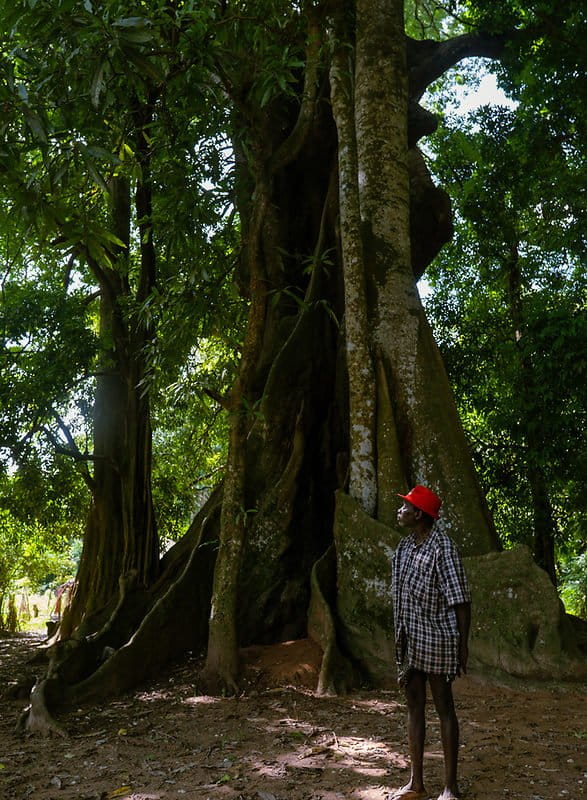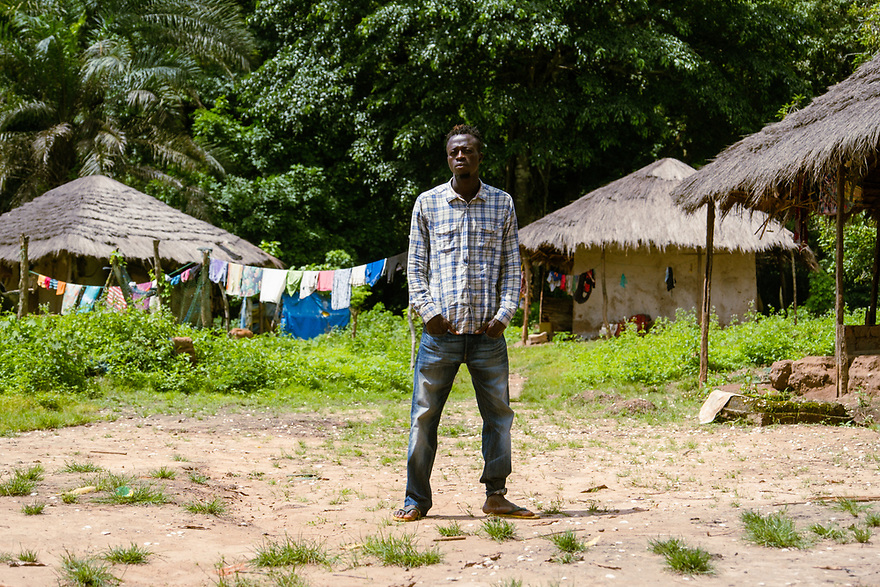- Communities in the Bijagós Islands off Guinea-Bissau have for generations maintained a close spiritual connection to nature that’s been credited with the archipelago remaining a biodiversity hotspot.
- In recent years, the islands’ young people have been turning their backs on these traditions in favor of education and jobs on the mainland.
- Community elders say they worry that long-held traditional knowledge, such as of plant-based medicines, will be lost.
- But the young people haven’t abandoned the Bijagós altogether, with many returning as trained nurses, midwives and teachers, bringing much-needed services to their communities.
Quinta Monteiro and her son Nivaldo watch a Nigerian comedy show on TV as they sit in their living room in Guinea-Bissau’s capital, Bissau.
The sound of cars zooming by can be heard just outside the apartment complex, but a reminder of Monteiro’s more rural past hangs above their heads. A skirt in green, yellow, black and red rustles softly in the breeze coming in from the window. The skirt is a ceremonial outfit from the Bijagós, an 88-island archipelago off the coast of Guinea-Bissau that was designated a UNESCO Biosphere Reserve in 1996. Monteiro, like her husband, Pedro Gomes, was born and raised on Canhabaque island, one of the 20-odd inhabited islands in the chain.
The skirt is worn for a variety of occasions, including coming-of-age ceremonies. Known as difuntu for women, and fanado for men, the ceremonies are rites of passage during which Canhabaquenos learn about traditional medicine, social contracts, and more. Most details of the ceremonies are a closely guarded secret among only the initiated. The forests where they take place are barred to anyone who has not undergone the initiation.
“When I was young, I did all the traditions, ceremonies, the difuntu,” Monteiro says. “After, I wanted to have more education, to know how to read and write. I came to Bissau [on the mainland] because I wanted to study nursing. Nowadays, young people don’t want to stay there [in Canhabaque]. They come to Bissau to study, nursing, education, and more.”
There is no high school on Canhabaque, with a population of around 3,800 people. To continue their studies, a young Canhabaque resident must leave for the mainland.

No place like home
Local leaders from the island say the younger men and women who leave for school sometimes return. But when they come back, their relationship with the ceremonies and the island chain’s sacred forests is changed.
“With the emigration of young people out of Canhabaque, culture and tradition has been lost. Because young people are studying and are less and less interested in tradition,” says Domingos Martinho, originally from Canhabaque but now an administrator on Bubaque, the main island in the Bijagós.
Martinho adds that increased educational opportunities have had positive impacts on the 18 villages on the island. “Canhabaque now has nurses, teachers, when the young people who went to study return to the village.”
Monteiro herself returns to the island each year and works at the local health center. “Because in Canhabaque, we are in a bad way in terms of medication. We do not have a health center in good condition,” she says. “It is necessary to join forces to help Canhabaque. When I return to help family members and the population, I am a midwife to help pregnant women during childbirth, to help reduce maternal and child deaths.”
But while many like Monteiro return with their new knowledge to help in the community, Martinho says he worries that other forms of knowledge important to the communities’ relationship with the islands’ forests are being lost.
The Bijagós archipelago is home to around 32,000 people, living on just a quarter of its 88 islands, where they grow rice and oil palm, cashews and kola nuts, as well as catch fish and raise livestock. Some of the uninhabited islands are used for seasonal agriculture and grazing, and some are set aside as sacred, accessible only to the initiated and ceremonies.
Migrant fishermen from Senegal, Liberia and Sierra Leone have also been settled in parts of the archipelago since at least the 1990s, with their use of mangrove trees for fuel or construction, and disregard for local customs — including sacred forests or seasonal fishing closures — sometimes provoking tension with locals.
Overfishing by these small-scale fishers, along with largely unregulated fishing by industrial trawlers in deeper waters, is one of the threats to the archipelago’s ecology. According to the Ramsar Sites Information Service, tourism, bauxite mining in nearby parts of the mainland, and offshore oil exploration are the other major threats to ecosystems here.
The islands are a stopover for thousands of migratory birds, and year-round habitat for saltwater hippos and manatees. The largest West African breeding sites for green sea turtles are also found here. Two national parks have been created to help protect this biodiversity.

Changing culture
The Indigenous knowledge and culture of the Bijagós are important factors in the area remaining a biodiversity hotspot. That culture is closely tied to the fanado and difuntu and other ceremonies, the rules in place for who can enter certain areas, or guiding when and how much should be harvested.
On Canhabaque, only those who have undergone the coming-of-age ceremony can enter into formally recognized marriages, make decisions about the use of land, or take up certain roles such as village chief.
“Before you undergo the fanado, you will always be considered a young person, even if you are 50 years old,” says sociologist Raul Fernandes, a coordinator at Guinea-Bissau’s National Research Institute, who has worked with residents on Canhabaque for decades.
But the strength of this tradition is waning, Martinho says. “Twenty years ago, 100% of the men in the Canhabaque village had knowledge of traditional medicine, but nowadays maybe 30 or 40% have this knowledge. The rest don’t know because they don’t want to go to the fanado.”
He adds that only men and women who go through the rites of passage are taught the complete depth of the traditional medicinal knowledge, which often uses plants and other resources found in the forests to treat ailments specific to the island.
“In Canhabaque, if you are bitten by a snake, you don’t die because you know the traditional medicine for that, but you can only have access to this knowledge if you go to the fanado,” Martinho says.
While former Canhabaque residents such as Monteiro tell the story of those who have left, young people still on the island express an interest in expanding their education but also staying in their hometown.
“The tradition of Canhabaque is inside of me, I can never reject it,’ says Cândido José Manuel, 27 years old.
Manuel has yet to undergo the fanado, but he says he will participate when it is his turn. The ceremony does not take place at a fixed date, but is usually held once every 15 to 20 years.
Sitting next to Manuel in their village of Ambeno is Sane Mane, the male head of the town. Mane insists the problem is not too many people leaving the village, but that those who stay no longer want work the land.
“When I was young, I worked for my father in the fields,” he says. “But now the youth of the village, you ask them to go work in the fields with me, they refuse. Maybe it is because everyone would rather go to school?”
Part of what irks Mane here could be the breakdown of Bijagós culture’s age-based hierarchy. But Martinho also points out that, while many students come back to the village during their school holidays, those dates do not correspond with the seasons when agricultural workers are needed.
“Yes, they come back, but usually during the vacation time in July, and at this time there is no cultivation, no work in the fields,” he says. “It is March, April and May, three months for growing rice. This period is the school period.”
This also affects young people’s participation in ceremonies for harvests and more, which are held in addition to the fanado and difuntu.
“The ceremonies are held from January to April, the traditional ceremonies are all in the dry season,” Martinho says. “When they come back in July, the traditional ceremonies are no longer held as it is the rainy season. And on the other hand, young people who are at school do not really want to do the traditional ceremonies because they are physically difficult. For example, the man who goes to the fanado needs to stay four months in the forest. There are young people who are at school, who do not accept to do that.”

New realities
Monteiro and her husband both participated in these coming-of-age ceremonies; but they say their two children will not.
“The reality we live in today is not the same as it was. My children, like the youngsters of this generation, no longer accept to undergo the fanado ceremony in the forest, stay for days in the forest, doing heavy work,” says Pedro Gomes.
But Gomes says he thinks his children will have an expanded vision of what is possible, thanks to their childhood on the mainland.
“My children will be more environmentally aware than I am, because they are at school, they are studying what the environment is and how important it is,” he says.
Fernandes, the sociologist, says he’s not so sure. He says the cultural rituals of Bijagós are essential to the maintaining and passing on the transmission of rules, and a social contract. “But like everywhere else, new generations are weaving their own new rules to amend social contracts with the older generations,” he says.
“Tradition is also a way of limitation,” Fernandes adds. “You can’t just take the tradition as something always good. Especially for women. Modernity is sometimes a person’s way to construct their individuality.”
In their living room in Bissau, Gomes says he’s thinking not only of the future of his children, but also his own.
Despite spending decades on the mainland, he plans to retire on Canhabaque Island.
“When my children grow up, I’ll go there,” he says. “To live peacefully by the sea. At 60 years old, I’m going to retire, and I am going there.”
Technology and tradition team up to watch over a sacred island’s sea turtles
Citation
Cross, H. (2015). Displacement, disempowerment and corruption: Challenges at the interface of fisheries, management and conservation in the Bijagós archipelago, Guinea-Bissau. Oryx, 50(4), 693-701. doi:10.1017/s003060531500040x
Banner image: Green sea turtle monitors from Canhabaque Island. Image by Ricci Shryock for Mongabay.
FEEDBACK: Use this form to send a message to the author of this post. If you want to post a public comment, you can do that at the bottom of the page.
